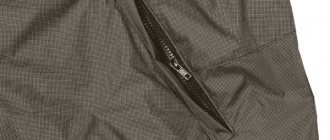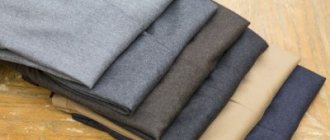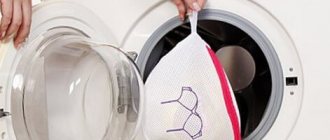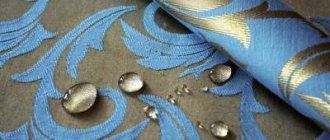Updated: 06/30/2021 12:52:01
Synthetic items are durable and wrinkle-resistant, but require more frequent washing than items made from cotton or silk. To maintain their original appearance, you must follow the rules for washing and caring for them.
We have prepared a number of recommendations for properly washing synthetic items.
Is it possible to wash a jacket in a washing machine?
Washing a jacket in an automatic washing machine is at least convenient and economical. Outerwear gets dirty quickly and needs frequent washing, and taking the item to the dry cleaner every time is not the cheapest pleasure. Of course, there is a way out. The first step is to determine what material the jacket is made of and whether there is filling inside it. Usually the clue lies in the symbols on the label, which is sewn into the product itself. It indicates the permissible washing temperature, mode, permission or prohibition for washing in an automatic washing machine. If the tag has a triangle symbol crossed out by two lines, then washing in a washing machine is prohibited. In other cases, you can wash the jacket.
A general set of rules for washing a jacket is as follows.
- Any jacket should be washed separately from other items.
- For jackets made of thin material, you can use a special washing cover.
- A jacket filled with padding polyester can be easily washed in a washing machine. Choose a mode for washing synthetics with a water temperature of no higher than 40 degrees.
- Leather and faux leather jackets are best cleaned by hand, but some items can be machine washed. Carefully study the label of a specific item.
- It is not recommended to wash jackets made of membrane fabric in a machine; they can only be washed by hand. Also, bleach should not be used on membrane jackets.
- The most optimal temperature for washing a jacket in a machine varies between 30-40 degrees. At higher temperatures, the fabric may become dull and fade.
- Before washing, check your jacket pockets, take out all unnecessary items, and fasten all zippers. Separate the fur, belt and other removable parts from the jacket, and turn the product inside out.
- Set the extra rinse function in the washing machine, this will protect your jacket from streaks.
- To wash your jacket, it is best to use a liquid detergent rather than a powder. It's easier to rinse out.
- The optimal spin cycle is usually indicated on the label. If it shows a square with three vertical stripes, then the jacket can only be wrung out by hand.
Big trend - 2019/20: what fashionable long jackets to wear in autumn and winter
Preparing for washing
To wash synthetics use:
- washing powder designed specifically for synthetics, wool or silk;
- soap (laundry soap or other soap that is on hand, but colorless).
When hand washing synthetics, use as much water as possible. After washing the laundry in several waters, it is necessary to rinse the item - do not wring out the item.
Also consider the type of fabric:
- Acrylic.
Such products are washed by hand in regular warm water or in a machine, setting the “Delicate” mode. It is not advisable to iron the fabric - ironing is only permissible through gauze soaked in water.
- Acetate.
Unresistant to wear, highly electrified, yet light and soft. As in the previous case, the “Delicate” mode and hand wash are suitable. Additionally, an antistatic agent should be added to the compartment. Ironing - through wet gauze and from the inside out.
- Polyester
. Water temperature – up to 40 °C; add an antistatic agent when rinsing the product. Ironing – iron in “Silk” mode up to 150 °C with moistened gauze.
- Polyamide, polyurethane, elastane
. Water temperature – up to 30 °C with the addition of products for silk or wool. Drying in direct sunlight is prohibited. Ironing modes – “Napron” or “Synthetics”.
Do not exceed the maximum temperature of the water or the heating of the iron - otherwise the item will acquire a yellowish tint and the fibers will begin to melt.
Regardless of the type of fabric, always read the label information. The manufacturer informs you at what temperature and how to wash a particular item, and whether it can be ironed.
Before washing, you need to soak the item for half an hour in a container with detergent dissolved in warm water. If it is heavily soiled, wet the item and apply a small amount of chlorine-free stain remover to the stain. Next, rinse the fabric and wash the item - in a machine or by hand.
Is it possible to wash a down jacket in a washing machine?
A down jacket is a little more difficult to wash than a jacket. The filling of a down jacket can become matted, so it is important to take additional safety measures. Regardless of the filling, it is best to wash a down jacket in a special bag and with tennis balls in the drum to avoid unevenness after washing.
- Be sure to turn the item inside out before washing and fasten all zippers.
- The down jacket must be washed at a temperature not exceeding 30 degrees.
- To wash a down jacket in the washing machine, select a delicate wash cycle.
- Spinning during washing is prohibited for most down jackets, so turn off this mode before turning on the machine. Carefully study the signs on the label; perhaps the down jacket is allowed to be wrung out by hand.
- It is best to wash a down jacket in a washing machine with liquid detergent, which does not leave streaks on the surface of the product.
- After machine washing, it is necessary to dry the down jacket in a horizontal position to avoid lumps or unevenness from matted filler.
- It is best to wash a down jacket once during the entire season, and remove small stains manually using wet wipes and a brush.
Rules for drying and ironing synthetics
Some synthetic items iron out on their own: just dry them flat. If the product needs ironing, maintain the maximum temperature depending on the type of fabric:
- fabrics containing nylon are ironed with an iron at temperatures up to 100 °C;
- The maximum temperature for lavsan is 140 °C.
Acrylic fabrics and chlorine do not require ironing.
Do not store laundry crumpled, as the remaining creases will be difficult to remove by ironing and may remain after washing.
Is it possible to wash a coat in a washing machine?
For a coat with down filling, use the same washing rules as for a down jacket. Coats made of wool, polyester and other materials have their own recommendations. Typically, manufacturers do not allow washing coats in an automatic washing machine, but all cases are individual. Firstly, check the label, and secondly, soak a small edge of the coat in water: if it does not stain, then you can wash the coat in a machine.
- How to machine wash a coat depends on the type of fabric. It is best to wash a woolen coat by hand, and to wash it in a machine, use the “hand wash” mode.
- A polyester coat can be washed in a machine without a twinge of conscience, this material can easily withstand washing. Set the mode to 40 degrees and turn off the spin.
- Cashmere coats should absolutely not be washed in the washing machine! The same goes for drape fabric: dry clean only.
- Use only liquid powders to wash your coat.
Features of washing a blanket
It is recommended to dry clean synthetic blankets, otherwise the product risks losing its shape. If this is not possible, you will have to wash the blanket at home.
If the drum capacity is from 5 kg, then:
- Add a blanket to the machine.
- Add liquid and conditioner.
- Set the mode to “Delicate”, spin to minimum.
- Activate extra rinse.
- Remove the blanket and lay it out on a table or other smooth surface.
- Turn the blanket over from time to time to ensure it dries evenly.
If the blanket is large and heavy, you will have to wash it by hand. For this:
- Fill the bathtub with warm water.
- Add washing powder.
- Soak the blanket in water for 10-15 minutes.
- Wipe the surface of the product with a sponge.
- Rinse the blanket well several times.
Let the water drain and lay the blanket on a flat surface.
Is it possible to wash sneakers in a washing machine?
Washing sneakers in a washing machine is difficult, but it is possible. There are several useful recommendations for washing shoes that you shouldn’t neglect if you don’t want to ruin your favorite pair of sneakers.
Cheap sneakers from an unknown brand are much more likely to deteriorate after machine washing than shoes from well-known brands. No one will give a guarantee, every wash is a risk.
Most often, there is a sign on the label of sneakers that prohibits machine washing, but do not be afraid: in most cases, the sneakers are quite durable.
- It is better not to wash sneakers with overlays, reflectors and stickers in a washing machine: the decorative elements may fall off.
- Sneakers and insoles should be removed before washing and should be washed separately by hand or soaked in a bowl of detergent.
- Remove pebbles, sand and small debris from the soles, which can lead to damage to parts of the washing machine.
- It is best to use a special bag for washing sneakers. If there is no bag, then immerse unnecessary rags or shoe mats in the drum to reduce the beating of sneakers against the walls of the drum.
- The washing temperature for sneakers is 30-40 degrees.
- Don't put it on spin mode, it can ruin your sneakers forever.
- Turn off the machine drying function to avoid damaging your sneakers.
How to wash synthetics by hand
Procedure:
- Fill a bowl with warm water and add detergent - preferably gel;
- Soak the item for half an hour;
- Gently remember the products with your hands, then rinse several times.
Attention! You cannot rub synthetic items with force, otherwise the fibers will be deformed, which will ruin the appearance of the product.
After washing, you must wait until the water has drained (do not twist the item) and hang the clothes on hangers to dry.
By the way, if a synthetic item is too large, then its size can be reduced. To do this, carefully wash the product in warm water, let it drain and place it inside out on a hot radiator or directly under the sun's rays. A similar method can be used for polyester and nylon. Things made of acrylic, lycra and spandex do not shrink.
Is it possible to wash a blanket in a washing machine?
- Blankets, like pillows, can be filled with different fillings. The principle is still the same: to prevent the “filling” of the blanket from rolling up, use tennis balls and a laundry bag.
- Choose a temperature range of 30−40 degrees.
- For synthetic blankets, use the “synthetic” mode, for those with down filling inside, turn on “down”, and in other cases, “delicate” is suitable.
- Duvets with down filling most often cannot be washed with the spin function, so turn it off during washing.
- Sushi washed blankets horizontally.
Characteristics of “Synthetics” on Bosch equipment
If we look at the Bosch model range, not all washing machines of this brand have a “Synthetics” button. Some “old” units have “Mixed Fabrics” instead, which are also suitable for safely washing clothes made from artificial materials. But it is better to choose a special synthetic program.
“Synthetics” on Bosch has several key features. As a rule, we are talking about the following parameters:
- The water heating temperature is automatically set to 30-40 degrees;
- cycle duration varies by user (from 70 to 140 minutes);
- The spin intensity can be changed at your discretion;
- By default, only a single rinse is offered, but an additional cycle can be enabled if necessary.
On old-style Bosch washing machines, a “Mixed fabrics” button is provided for washing synthetic items.
When washing artificial fabrics on Bosch, you can adjust the cycle for better washing. Housewives focus on the type of material, number of stains and quality of clothing, setting the most optimal parameters. It is also important to control the degree of filling of the drum - ideally, you should load half of the maximum capacity into the machine. As for detergents, it is advisable to use gels and liquid concentrates that dissolve faster in cold water.
How long does it take for an Indesit machine to wash?
Indesit program table: description and designations
| Name | Designation | The approximate time* |
| Jeans | You will see a picture of jeans on the panel. | |
| Express 15 | Duration: 15 minutes. | |
| Sport shoes | The panel shows sneakers. | Cycle time – 50 minutes. |
| Sport | Image of a soiled T-shirt. | Wash for 1 hour 18 minutes. |
“Synthetics” parameters on Siemens machines
On washing machines from Siemens, a special mode for cleaning synthetic fabrics is rare. The manufacturer invites the user to independently set the settings for each cycle, which is not entirely convenient for daily use. For those who have a lot of nylon and polyester clothing, it is better to learn the recommended parameters or consider a machine from another brand.
So, cleansing in the “Synthetic” mode goes like this:
- temperature range – 30-60 degrees (varied by the user within the specified limits);
- one-time auto-rinse (if necessary, a repeat cycle is activated);
- spin can be set at any level, from maximum to deactivation);
- The duration of the cycle depends on the parameters set, but does not exceed 105 minutes.
For high-quality washing at Siemens, it is better to load no more than 2.5 kg of artificial fabrics into the drum. Intensive drying is not supported when choosing “Synthetics”. On some of the manufacturer’s machines, instead of a special mode, there is another one - “Mixed laundry”.
Manual cleaning of synthetic products
Washing polyester by hand will take longer than washing it automatically, but this method guarantees the most gentle cleaning of the fabric.
Warm water at a temperature of 30-40 degrees is filled into a basin. You can use powder, but small granules are not always completely washed out from the structure of the matter, since they take a long time to dissolve in liquid. Therefore, it is recommended to purchase liquid products. Washing gels and shampoos do not leave stains on the fabric.
For heavily soiled clothes, first soak them in soapy water for 20-30 minutes. Contaminated areas can be cleaned with a soft brush. Although polyester fibers are not susceptible to mechanical damage, you should still not rub the fabric too hard with a brush. Then the product is rinsed with warm water, gently squeezed and the moisture is allowed to drain. Jackets, coats and raincoats are not wrung out; they are dried on hangers.
Why does shrinkage occur?
The main reason for shrinkage is the peculiarities of fabric production. During creation, the fabric is deliberately stretched, and during washing the material tries to regain its optimal shape, as a result of which its length and width decrease. If the threads (warp or weft) have been twisted or compressed too much, when wet they will try to straighten out, but this will happen by shortening the threads that run either across or along the fabric. Another common cause of shrinkage is fiber swelling. In this case, the threads become thicker and shorter.
Cotton
Cotton items must be sorted by color and degree of soiling before washing. 100% cotton fabrics are subject to shrinkage. They must be washed at low temperatures - from 30 to 40°C. When washing cotton, the choice of powder is very important. The best solution is powders with enzymes. For dense fabrics, a spin speed of up to 800 rpm is allowed. Do not use automatic drying. It is better to straighten the item and, without waiting for it to dry completely, start ironing. This will help avoid wrinkles and maintain its shape.
Removing stains from fabric
There are various unpleasant situations in life that can be remembered in the form of dirty stains on clothes.
Splashes from passing cars, stains from tea, coffee, juice or sauce, and stains from sweat may remain on fabric products. For pre-treatment you will need a mild stain remover. To avoid damage to the fabric, you must select an inconspicuous area of the product to test the product. Processing should be carried out on a hard surface, for example, on a table. Instead of a brush, it is best to use a metal spoon, the convex side of which is used to distribute the stain remover. Thus, the fibers will not be damaged and the base will not be deformed, as happens when processing fabric by hand. After a certain time, the product is washed manually or automatically.
There are other ways to clean stains from polyester. Table salt is applied to the moistened area with the stain, the crystals of which tend to absorb dirt. The fabric is washed in a soapy solution and then rinsed in clean water.
Particularly stubborn stains can be removed with a 10% borax solution. Using a cotton swab, apply the product to the contaminated area. Neutralization is carried out using a solution of citric acid or lemon juice. Then the product is rinsed in cool water.
Which fabrics are most susceptible to shrinkage?
Fibers that shrink the most are those that can absorb the maximum amount of water and change their size when wet. Such fabrics include cotton and linen materials, as well as viscose. Woolen fabrics vary greatly in size. In this case, not only the diameter of the yarn changes, but also the structure of the fabric itself. Shrinkage during washing is also possible with corduroy and tartan, and fabrics such as chintz, cambric, poplin, teak, satin, calico and a number of others are less susceptible to shrinkage.
“Shrinkage greatly depends on the composition of the fabric, and it is not always possible to correct everything. The item can be corrected if it is wool that has a rough knit. Under steam, you can pull it a little and increase the product by one size. But there is such shrinkage that nothing can be corrected. This is the result of the wrong temperature being selected during washing. Nowadays, household machines have been improved; they have a delicate wash mode. Certain modes have a pre-programmed low temperature. You cannot act according to your own judgment or be in too much of a hurry when putting things away for washing. First of all, you need to read the labeling and see how to wash and dry things,” says dry cleaning manager Irina Yakush .
Samsung cars
The Synthetic mode is found on the control panel of almost every automatic machine of the brand. In the instruction manual you can find a detailed description of the program, as well as a list of products allowed for cleaning under these parameters. For what things will the mode be ideal? The manufacturer allows washing blouses, shirts, shirts and other items made from synthetic fibers. Basic washing parameters within the program:
- the water temperature in the tank reaches 60°C, however, at the user’s discretion, the heating can be reduced to 40 degrees;
- pre-washing is not provided by the intellect;
- the default spin speed is 800 rpm, but the value can be increased up to 1200 rpm, if such a possibility is provided for by the characteristics of the equipment;
- average water consumption varies from 50 to 62 liters.
To increase cleaning efficiency, the manufacturer recommends putting no more than half of the drum into the machine at a time. This way the quality of washing will be perfect.
In most cases, there is no original designation on the control panel; the name of the program is simply written near the programmer knob - Synthetics.
On Indesit equipment
The vast majority of Indian washing machines are equipped with the “Synthetics” program. Modern washing machines from Indesit have gone even further and offer the user two options for synthetic cycles. Each has some features that are worth considering when choosing a button.
When you select the first one, the machine will heat the water to 60 degrees and activate a spin cycle of 800 revolutions. In this case, pre-washing will not be possible, but if desired, you can turn on the “Bleaching” function. This cycle lasts at least 75 minutes.
Modern washing machines from Indesit offer two synthetic cycle options.
"Synthetics-2" offers a lightweight cleaning option. Here the water will heat up to a maximum of 40 degrees, which will reduce the cycle duration to 71 minutes and eliminate the activation of “Whitening”. Otherwise, the cycle settings will not change.
Characteristics of “Synthetics” on Samsung washing machines
As for Samsung washing machines, the “Synthetic” program is considered basic and is present on almost all models, both expensive and budget. It can be used to wash any shirts, dresses and blouses made from artificial fabrics. The cycle parameters are:
- pre-wash is not supported;
- maximum temperature is 60 degrees, but can be reduced to 40;
- spin is automatically set to 800 rpm, but the rate is freely adjustable to maximum or minimum.
When washing artificial fabrics, it is recommended to load up to 2.5 kg of dry laundry into the drum, regardless of the capacity of the machine.
Samsung recommends washing synthetics when loading the drum with no more than 2.5 kg of dry items, regardless of the capacity of the machine. Thanks to the “freedom”, clothes are washed and rinsed better. It is worth considering that in this mode at least 50-62 liters are spent in one cycle.











